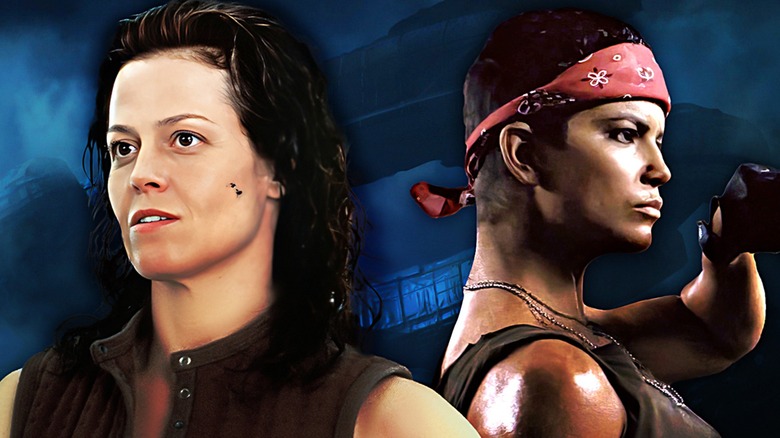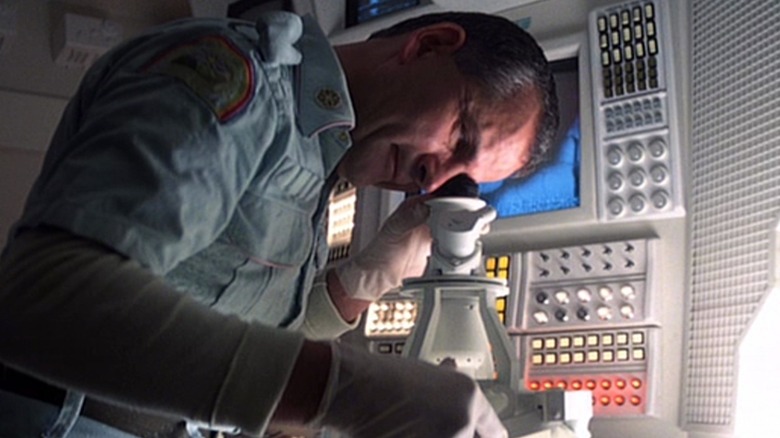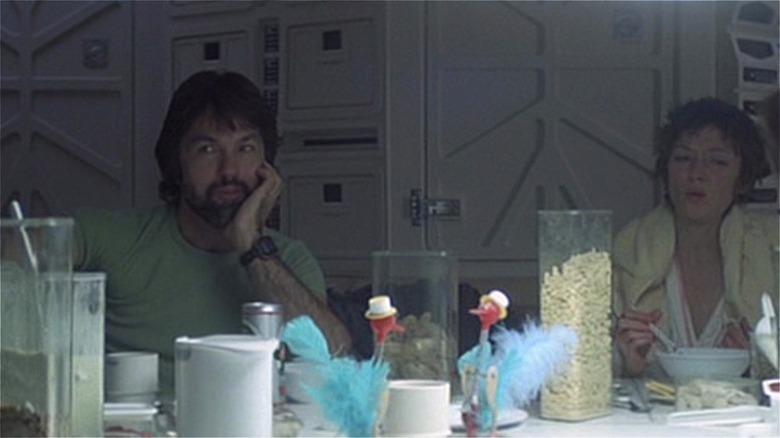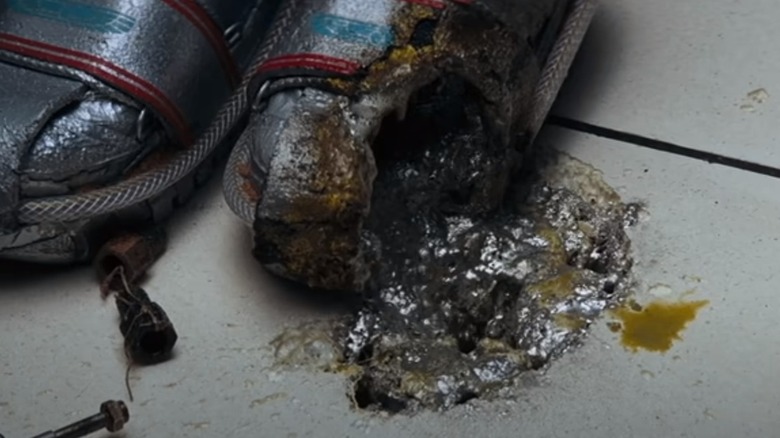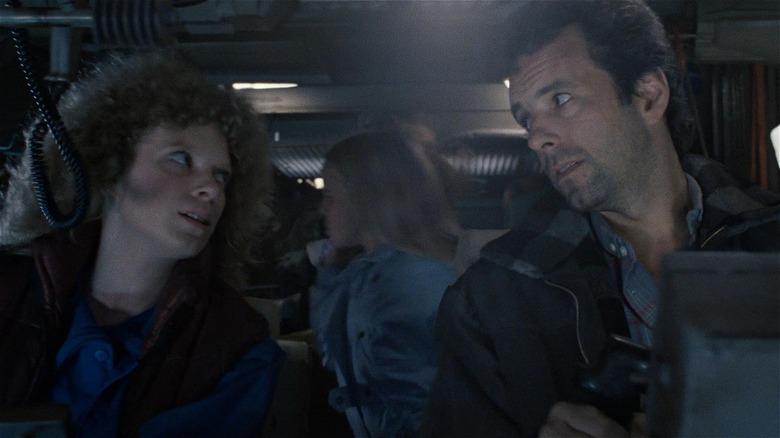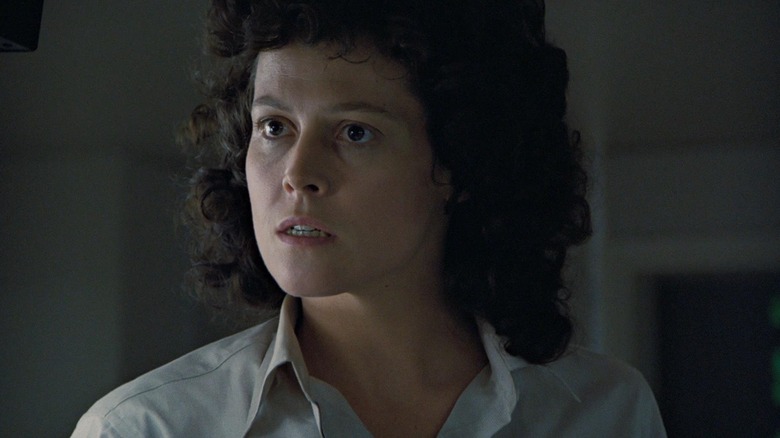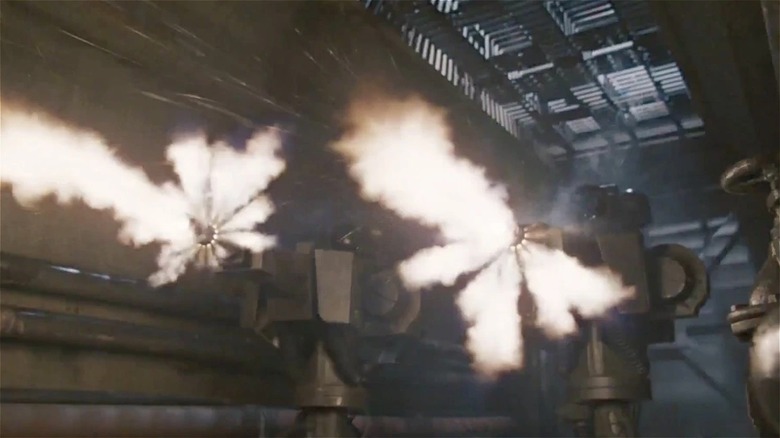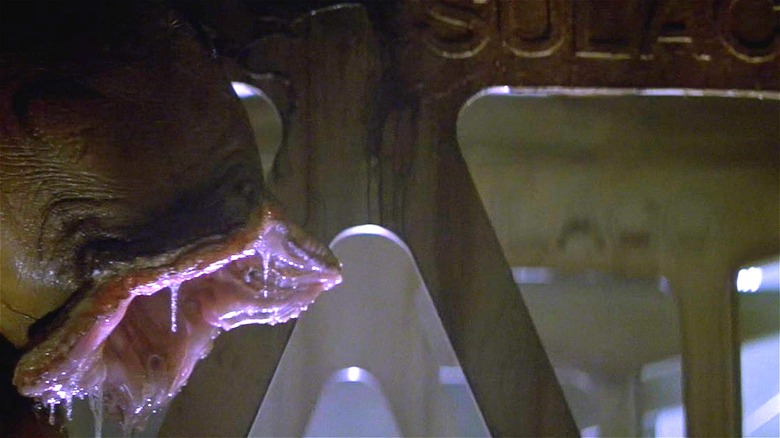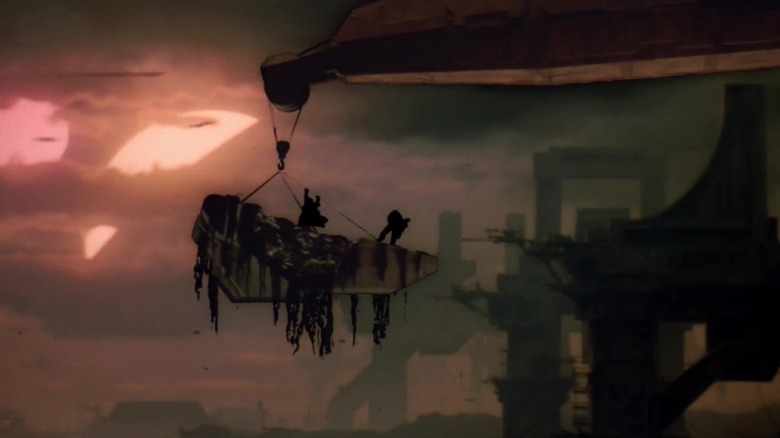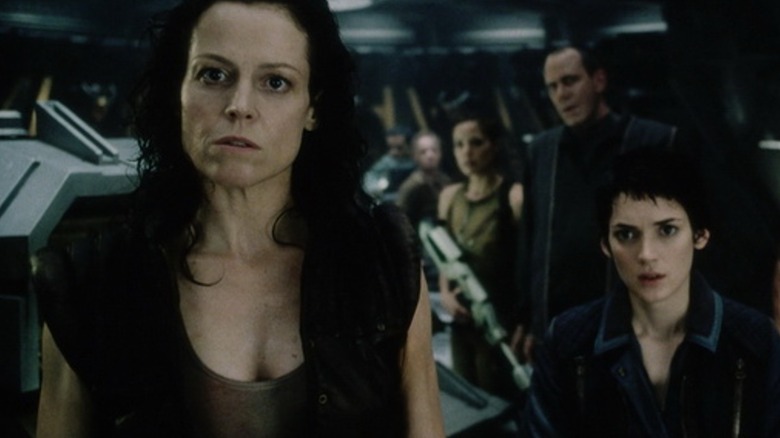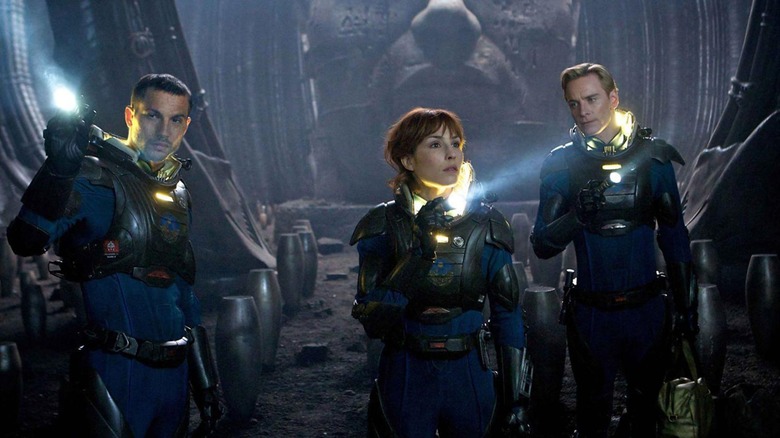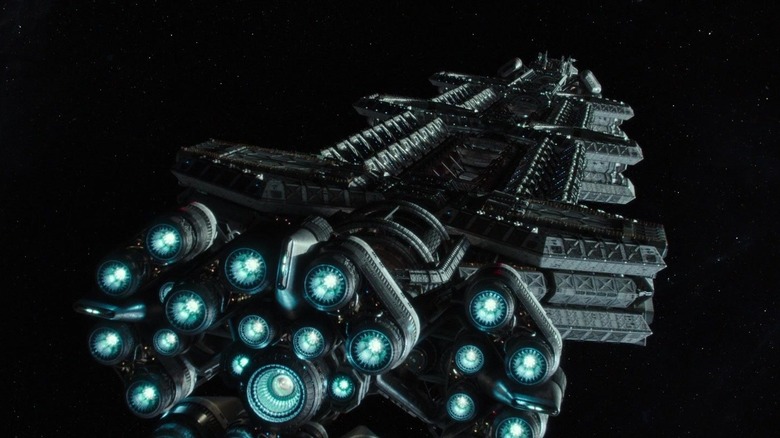The Biggest Plot Holes In The Alien Franchise
With its somber, atmospheric settings, stellar acting, and the beautifully rendered yet horrifically disturbed biomechanical designs of H.R. Giger, "Alien" is one of the best science fiction horror films ever produced. And while every film in the franchise is not a winner, the rich worldbuilding they offer when taken as a whole pairs perfectly with the franchise's bleak view of a future where corporate and military interests are at odds with human compassion and connection. But like most good science fiction, the "Alien" saga tends to work best when you don't look too closely at the finer plot points — because therein lie some pretty big holes.
The longer a franchise goes on, the bigger the overarching story becomes. So it should come as no surprise that with nine films, a web series, a handful of video games, and an upcoming "Alien" television series, the xenomorph universe has its share of plot holes. While "Prometheus" tends to get dunked on the most for its plot holes, the rest of the franchise is hardly innocent, containing everything from forgotten plot points to glaring continuity errors. Grab your flamethrower as we take on some of the most egregious plot holes in the "Alien" franchise.
Alien: Weyland-Yutani's actions don't make a lot of sense
A major recurring theme in the "Alien" franchise is unchecked collective greed and corporate exploitation by tech mega-conglomerates and the billionaires behind them. This theme remains consistent throughout the franchise, even if the implementation sometimes borders on cartoonish (see: "Alien: Resurrection" and "Prometheus"). The amorphous Big Bad of the franchise is Weyland Corp, the massive tech entity later rebranded as Weyland-Yutani after a 2099 merger with the Yutani Corporation. This ever-evolving organization that the Nostromo crew calls "The Company" is perennially trying to get its mitts on alien tech — and they're willing to write off humans to that end. But, if the "Alien" films superficially make it seem like the company has any sort of well-considered machinations at play, any closer inspection starts to make those plans look shaky.
Although Nostromo's investigation of the Derelict initially seems coincidental, Special Order 937 eventually reveals that the company set the crew up to obtain an alien organism for experimentation. However, without having actually encountered the xenomorph, how could they know it was worth risking an entire ship and crew to obtain — not to mention the potentially astronomical settlements that would need to be made following the mass loss of crewmen and their families? Xenomorph fans who couldn't let this go would finally see an explanation canonized in the 2014 book "Alien: The Weyland-Yutani Report." According to the report, the Prometheus expedition led to the creation of the 900 series of special orders, all aimed at helping Weyland-Yutani acquire any extra-terrestrial technology it could, regardless of cost.
Alien: The drinking birds are apparently magical
A subtle plot hole that's hard to overlook once you've seen it is the "Alien" drinking birds conundrum. A quirky novelty item, a drinking bird or "dippy bird" is a small bird toy with fluid inside its body that works as a heat engine, causing the bird to apparently "drink" perpetually from a cup of water. Although the birds will continue to drink as long as their beaks touch the water, eventually the water in the cup will evaporate enough that the bird stops, which usually takes less than a week. Since the Nostromo crew has ostensibly spent weeks in cryosleep at the beginning of "Alien," there's no reason why the dippy birds seen in the film's opening sequence should still be in motion as the crew is seen waking up.
Since the Prometheus expedition's android David (Michael Fassbender) spent his crewmates' cryosleep period refining his Engineer language skills, it might make sense that Ash (Ian Holm), the Nostromo's android, was awake while his crewmates slept. But the film clearly shows Ash lying in a cryo-chamber as part of his ruse, despite a fan theory from Redditor u/I_Raptus that suggests the birds could signify Ash was secretly creeping around the ship at some point during his crewmates' stasis. The thing is, even if Ash woke up mid-sleep to move around the ship, why would he bother giving the dippy birds more water, something that could potentially alert the crew that something was amiss?
Entire franchise: The whole acid blood thing is inconsistent
There are plenty of barely comprehensible details about xenomorph physiology, like their physics-defying growth rates. One of the strangest details about xenomorph biology is that their blood only seems to be corrosive at certain times, and it's a problem that is endemic throughout the franchise. The deadly acidic quality of alien blood is established early in "Alien" when the first facehugger is removed from Kane (John Hurt). The creature's blood eats through two decks of the ship within a matter of moments. This is seen again at various points throughout the franchise, like when Hicks' (Michael Biehn) chest armor gets melted through in "Aliens." Acidic blood also plays a key role in the non-canonical "Alien vs. Predator" series, with the predators using it to mark their xenomorph kills.
The idea of the aliens having acid blood is great in theory, but a lot of viewers have pointed out that this only seems to be the case when it suits the plot, and that's frustrating for fans of the franchise. One of the most egregious examples can be found in the climax of "Alien" when Ripley (Sigourney Weaver) shoots the xenomorph with a grappling harpoon: In theory, the tether should have melted, setting the alien free in the process. There's also the fact that Ripley 8's blood melts away glass and steel in "Alien: Resurrection" but seems to have no impact on the surgeon's gloves and tools. It seems like the filmmakers would rather create a plot hole than have the preestablished facts get in the way of a good scene.
Aliens: Why didn't Hadley's Hope pick up the distress signal?
"Aliens" jumps ahead in the timeline by 57 years. Weyland-Yutani has established the terraforming colony Hadley's Hope on LV-426 — the same moon where the Nostromo crew found the Derelict. After Ripley is rescued, her testimony leads the company to investigate the location of the ship, which almost immediately causes the colony's xenomorph infestation and subsequent collapse. However, after watching the movie, viewers couldn't help but wonder how an entire colony could be built in the backyard of the Derelict ship and completely miss the warning signal that initially alerted the Nostromo crew. If they had, Weyland-Yutani surely would have dealt with the alien problem before terraforming the planet and Newt's parents surely wouldn't have dragged their kids out to the wreckage.
Responding to criticism of the film in Starlog magazine, writer/director James Cameron explained this away by stating that the ship had been damaged at some point. "Since we and the Nostromo crew last saw it," Cameron wrote, "it has been damaged by volcanic activity, a lava flow having crushed it against a rock outcropping and ripped open its hull. Aside from considerations of visual interest, this serves as a justification for the acoustic beacon being non-operational." If that seems like a hastily-written excuse to cover up his own oversight, the fact that the beacon is turned off by Henry Marlow (the owner of a salvage vessel named USCSS Anesidora) in the canonical video game "Alien: Isolation" only further muddies the waters.
Aliens: Ripley knows more than she should at the inquest
After she is rescued in "Aliens," Ripley has to suffer through a corporate inquest in which she's forced to relive what she saw aboard the Nostromo. During the meeting, she reveals what Kane saw while aboard the Derelict, telling them, "Kane, who went into the ship, said he saw thousands of eggs there. Thousands." Although it's true that Kane did find a massive nest aboard the alien ship, he never tells her or the crew at any point that there were thousands of eggs. As Kane is initially lowered into the ship, he reports being in some type of a cave. He says that it feels the topics in there before eventually taking in the Engineers' architecture and artwork.
Once he reaches the bottom, Kane reports back the following: "The pit is completely enclosed. And it's full of leathery objects, like eggs or something." He never says anything about the number of eggs before he gets slapped with a facehugger, and he never mentions this again after recovering. Only the audience, Kane, and his rescuers Lambert and Dallas would have known how many eggs were down in the ship. If someone did eventually relay this information to Ripley, it decidedly was not Kane, since he doesn't seem to have any recollection of the event after waking up post-facehugger removal.
Aliens: Vasquez and Hudson send out a xenomorph beacon
There's a small but crucial plot hole in the extended special edition of "Aliens" that revolves around remote sentry guns. These guns show up in a restored deleted scene, with Ripley and the marines monitoring the aliens' progression toward them. To find out where the xenomorphs are coming from and follow their progress, the crew seals off some passages while placing sentry guns at others. As they stare at the computer monitor, Hicks announces that there are multiple targets at the A and B sentries. The tension mounts as the crew watches the ammunition rapidly deplete, creating a sense of inevitability about the hell headed straight for them.
However, before all this happens, Private Vasquez (Jenette Goldstein) and Private Hudson (Bill Paxton) have to set these guns up. While doing so, they decide to test out the guns by tossing a large metal canister into their path. Narratively, this serves as a way to show the audience how the sentry guns work. However, it's hard to overlook the fact that this test would have immediately alerted the xenomorphs to their exact location. It looks good, sure, but they might as well have been yelling, "Hey, there are people over here, come and get them."
Alien 3: The Sulaco egg shouldn't have been there
Of all the plot holes in the "Alien" universe, one of the most frustrating is the Sulaco egg in the divisive third film, David Fincher's "Alien 3." It's especially frustrating as the egg is central to setting up the entire plot of the film. After barely escaping the Nostromo only to lose 57 years in stasis aboard her drifting shuttle, then getting coerced into returning to LV-426 only to narrowly escape with young Newt, Ripley is wronged yet again when her escape pod crash-lands on a prison colony. To make matters worse, the crash occurs because of an alien egg that was hidden aboard the Sulaco when Ripley and Newt went into stasis — despite there being no way for this to happen in the "Aliens" story.
Unlike the action of "Alien," which took place aboard the Nostromo, "Aliens" is primarily set on LV-426 in the colony. Toward the end of the film, the Queen does end up getting on the dropship, but she doesn't have her enormous ovipositor needed to lay eggs, and she clearly isn't carrying anything when she emerges from the elevator just before she would have hitched a ride on the dropship. Fans have come up with their own theories about how the egg got there, some wilder than others, but there's a general acknowledgement that this is a real whopper of a plot hole. No matter what you think about "Alien 3," there's no getting around the fact that the film's MacGuffin really shouldn't have been there.
Alien 3: The EEV crash is never explained
Another big plot hole from "Alien 3" is the EEV crash. The film's intro establishes that a facehugger stowed aboard the ship and caused a fire, but there's never any clarity given on how the escape pod actually lands. Instead of drifting endlessly through space, the pod just happens to crash on the marginally habitable planet Fiorina 161, where there's a group of humans living. Perhaps more surprising is the fact that this cinder block of a ship didn't catastrophically incinerate upon entry. Space is obviously vast and this craft is clearly lacking in aerodynamics, so the fact that the vessel crashed in just the right place for Ripley to be rescued seems like a deus ex machina at best, and at worst, a gaping plot hole.
Like so many things in the "Alien" franchise, the answer can actually be found in the film's novelization, which describes the ship's computer as it locates the safest nearby planet to deposit the vessel. According to the Alan Dean Foster's "Alien 3," the pod would have landed safely if not for a power malfunction: "The computer tried. That was its job. But the EEV fell far short of the beach, slamming into the sea at too acute an angle." That kind of clears things up, but the issue is that the canonical status of this book is a little blurry. It's been described as Tier III canon as one franchise consultant, as it contains "some minor problems that can be explained away as myth or hearsay."
Resurrection: The Ripley 8 clone doesn't make sense
Considered by many fans to be the worst movie in the "Alien" franchise, Jean-Pierre Jeunet's "Alien: Resurrection" imagines a more distant future world where military scientists have decided to play Frankenstein with the hopes of harvesting a viable xenomorph embryo using alien-infused human DNA. This 1997 sequel (which was penned by Joss Whedon) informs us that the human genetic material in question belonged to Ripley: Her DNA was somehow recovered from Fiorina 161 after her infection.
It's never established when Ripley's bloodwork was taken in "Alien 3." We can only assume that it happened offscreen when Ripley wasn't canoodling with Dr. Jonathan Clemens (Charles Dance). However, even if that's the case, there's no established precedent for this. How much alien DNA would need to have commingled with Ripley's to make creating an alien queen possible? While it's true that some parasites have been known to alter genomes, and it's easy to write the whole thing off as aliens doing alien things, it does take a pretty big suspension of belief to get past the fact that this is never explained in-universe.
Prometheus: Did everyone forget about Charlie's infection?
If "Alien: Resurrection" is considered the worst entry in the "Alien" franchise, "Prometheus” is equally notorious for having the most plot holes. Fans love to nitpick about everything from how and why the Engineer cave art was created to why humans haven't encountered other intelligent life in the universe if the Engineers are responsible for seeding Earth's primordial ooze along with countless other worlds. For many, the film's biggest head-scratcher is how quickly the otherwise capable crew forget their basic epidemiology while removing their helmets inside the pyramid on LV-223.
Shortly after realizing the atmosphere contains breathable oxygen, Charlie (Logan Marshall-Green) removes his helmet despite protests from Shaw (Noomi Rapace), as if the gas content of the atmosphere is the only thing they need to be worried about. When he's able to breathe just fine, Shaw and the others join him, which kind of makes sense. What doesn't make sense is that, later on in the film, after Charlie has died from an infection he picked up in that pyramid, they all remove their helmets again when David announces the air is "perfectly breathable." Only Shaw wisely opts to keep wearing hers, warning them, "We still don't know how Holloway got infected."
Covenant: Neutrinos don't work like that
The second and final entry in Ridley Scott's "Alien" prequel film series (a third installment was planned but will probably never happen at this stage), "Alien: Covenant" is set in 2104 AD, 11 years after the Prometheus expedition. It follows the crew of a colonization ship heading for a planet called Origae-6. It didn't do as well as "Prometheus" did in terms of reviews, and part of the reason is that there are several huge plot holes present in "Alien: Covenant." One thing we would like to see explained is what actually went wrong with the USCSS Covenant.
After a so-called neutrino storm does damage to the vessel, the crew abandon their journey to Origae-6 and decide to head for a nearby planet after picking up what seems to be a human transmission. The issue here in terms of plot is that neutrinos are particles that have virtually no mass, meaning they cause zero reaction when passing through matter. It's said that around 400 billion neutrinos are passing through each and every one of us every single second, doing no harm. As such, they would not actually damage the Covenant.
